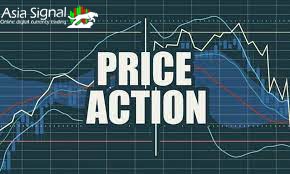"Price Action" and the strategies created from it are used by many traders interested in short-term analysis. Price action is a method used to analyze initial price fluctuations. The entry and exit Crypto Signal generated by price action are reliable and it is not necessary to use indicators in Binance Spot Trading Signals using price action. In fact, using price action is a form of technical analysis because it ignores the fundamental aspects of the stock and prioritizes its price history.
This history includes upward or downward price fluctuations, trend lines, and support and resistance levels. Price action simply shows how prices are moving. A price action analyst observes the relative size, shape, position, and volume of bar or candle charts and May sometimes combine them with information from moving averages and trend lines.
Price action can be viewed and interpreted using charts that plot price over time. Traders use different charts to more closely observe trends, breakout levels, and reversals. Many analysts use candlestick charts because it makes it easier to see price action.
Candlestick patterns such as "Harami Cross", "Engulfing" and "Three White Soldiers" are all examples of visual interpretations of price action. There are other candlestick structures that are derived from price action to predict future price movements. These structures can be used for other types of charts such as point and shape charts, box charts, etc.
In addition to examining the structures formed in the price chart, many analysts use price action data to obtain technical indicators. Their goal is to find the existing order in the price movement. A movement that sometimes seems random.
For example, the Ascending Triangle pattern created by applying trend lines to a price action chart can be used to predict a possible breakout because the chart indicates that traders have attempted to break the resistance line multiple times. And each time they have tried to do it faster and more powerfully.
Technical analysis is also derived from price action because it uses past prices to calculate and then make trading decisions. In fact, the structure and patterns of technical analysis charts all benefit from price action.
Psychological and behavioral interpretations and activities related to them, according to the analyst's opinion, include an important part of trading based on price action. For example, most of the time, no two traders will have the same analysis of a given price action and each of them will make a unique interpretation according to their defined rules and behavior.
If in technical analysis, for example, when the 15-day moving average is higher than the 50-day moving average, we will see a similar behavior and performance (holding the stock in anticipation of selling it at a higher price) from many traders.
Considering the importance of price action and learning its practical applications for all types of assets, "Faradars" has released a video on the introductory training of harmonic patterns, the link of which is below.
Applications of trading by price action
Since price action is used for price prediction and speculation, it is used by real persons, speculators, arbitrageurs and brokerage and trading companies. As stated in the introduction, price action can be used to analyze the price trend of many securities such as bonds, company shares, etc.
Trading steps by price action
Experienced traders use different measures to identify trading patterns, entry and exit levels, and limit loss. Using only one strategy for one or more stocks may result in missing a number of trading opportunities. In most situations, the following two steps are used for analysis:
Diagnosing the situation: In this step, the trader diagnoses the existing situation. For example, the price of a stock may be falling or rising, or the stock may be entering a certain price channel, or simply, the price trend is breaking resistance or support lines.
Recognizing trading opportunities in any situation: For example, when a stock's price trend is up, it may rise even more and experience a lot of volatility, or it may reverse and decline. It depends on the analyst's point of view, and even different analysts may have different perceptions of the same situation.
Example of trading by price action
In the following, we describe 3 examples of trading by price action according to the above steps.
The price of shares bought by a trader increases and reaches the contract peak defined by him. Further, the price of this stock decreases and settles at a lower level (situation detection). At this time, the trader must decide whether, according to his opinion, the stock price will continue to reach a higher peak and continue to be bullish, or whether it will decline and experience a "mean reversion".
A trader sets a floor and a ceiling for the price trend with the assumption that the volume of a certain stock is low and there is not going to be a breakout. If the price trend continues to move within the defined range (situation detection), the trader can decide to set support and resistance lines based on this range or to change his view angle and wait for the price trend to break the resistance levels. Or have support.
On the stock price chart purchased by the trader, a breakout of levels occurs (position detection). At this time, he faces two trading opportunities. The breaking of the levels continues and the price trend continues in the same direction or a pullback occurs and the trend returns to its previous position.
As can be seen, trading according to price action can be done with the help of technical analysis tools. But the final trading decision is determined by the analyst. Price action allows the trader to be flexible and make different decisions.

Popularity of trading by price action
Trading with price action is mostly for trading with the aim of gaining profit in the short or medium term. Most traders believe that the market follows a random trend and there is no clear systematic way to find a winning strategy. By combining technical analysis tools and recent price trends, positions can be identified depending on the analyst's perspective.
From the positive points of price action, it can be mentioned that analysts can take advantage of the strategies defined by themselves, and this creates flexibility in trading for them. Price actions can be used in all kinds of software and trading systems. Price action also allows easy "backtesting" of any strategy defined on old data. That is, you can enter the old data in the price action strategy and if the strategy and predictions obtained are effective, you can use those strategies.
There are traders who use several indicators for analysis like the one below. Some analysts also watch crowded charts like the one below on multiple monitors to gather enough and convincing reasons to buy and sell certain stocks. When you rely only on price trends for analysis, you get rid of these complexities.
Most importantly, when trading with price action, traders will feel responsible because price action allows them to make their own decisions and not blindly follow the rules.
Many theories and strategies implemented using price action claim to earn high profits, but the trader should be aware that only positive news is heard. Buying and selling shares has the potential to generate high profits, but it depends on the analyst to understand, test, choose and decide well and finally make a deal that he thinks will provide the best opportunity for profit.
What is binary option?
Binary option is a type of investment that is very similar to prediction and can be right or wrong. In this type of investment, the trader bets whether the price of the asset or share will be higher or lower than a certain point after a certain period of time.
This time period can be different and very short, as much as 60 seconds. If this prediction is correct, the investor will get back his paid amount along with a bonus. If the investor's prediction is incorrect, he will lose the entire amount invested in this trade.
One of the most important uses of price action is in binary trading. By using the price action binary option, you make all your decisions based on a simple price chart that is free of moving averages, oscillators and trend indicators. To apply this strategy, you will need a price chart with certain time periods.
The main axes of price action
Before examining trading strategies with price action, we must familiarize ourselves with its main axes. If you can recognize these things in the chart and understand the relationship between them, you will be successful in price action analysis to a large extent. Note that these expressions may seem simple, but their causes are complex. In the following, we will give a simple definition of the most important axes that create price action.
What is a candlestick chart?
Like a bar chart, a candlestick chart shows a high price, an open price, a close price, and a low price. The high price is the highest price that the target stock has had in a certain period of analysis. Low price has a completely opposite definition of high price. The closing price is the last trading price of the stock. The opening price, quite unlike the closing price, refers to the price of the stock's first trade in a given period.
As you can see from the components of the candlestick chart in the image above, the body of the chart shows the price range in a certain period of analysis. For example, if a trader analyzes on a weekly basis, each candlestick represents the price action of a week, and the body of each candlestick represents the difference between the share price at the beginning and end of the week. If in the black and white chart, the body of the candlestick is black or in the color chart, the body of the candlestick is red, it means that the opening price was higher than the closing price.
What is a bull trend?
"Bullish Trend" is observed when the prices are increasing and the chart is ascending. The bull trend observed in the analysis means that the price of the company's shares is increasing. At these times, investors are confident that the upward trend will continue. In fact, we see a bullish trend when the set of candles rises to the right. For better understanding, imagine a line with an angle of 45 degrees.
What is a bear trend?
"Bearish Trend" is observed when the prices are decreasing and the chart is falling. In a bearish trend, prices are continuously decreasing. This bearish trend will fall even more due to traders' belief that it will be bearish. Bear trend structure is the opposite of bull trend structure. At this time, the trend line is at an angle of 315 degrees.

What is a neutral market?
"Neutral market" (Flat market), unlike trending markets, has neither an upward nor a downward trend. In fact, the stock that is traded in the neutral market has a fixed price and experiences little changes. The market may remain neutral while investors wait for news of the IPO. According to Heikin Ashi Trader, an author with more than 15 years of experience in the binance futures signals market and the Forex market, the market stays in a state about 70% of the time. The probability of losing money in neutral markets is very high because the trader's expectations and market behavior are not aligned.
What is the support line?
"Support Level" or support level is a part of the chart where we expect the downward trend to stop as soon as it is encountered. A support line is formed due to increased demand or motivation of buyers. When the price of the share decreases, the demand for it increases, which leads to the formation of the support line. The share price trend may go below the support line and continue up to another support level.
What is the resistance line?
"Resistance Level" or resistance level is a part of the chart where rising prices stop and change direction and decrease. A resistance level acts as a barrier that prevents prices from increasing. Prices may finally break the resistance level and then reach another resistance line.
Trading strategies with price action
In the following, we examine 5 of the most important trading strategies with price action along with the chart:
Outside bar outside the support or resistance line
Spring in the support line
Inside bar after breaking levels
Long shadow candles
Measuring the length of previous swings
Outside bar outside the support or resistance line
"Outside bar" is a candle whose high price is higher than the high price of the previous candle and whose low price is lower than the low price of the previous candle. Therefore, the outside candle covers its previous candle. We have a bullish outer candle when the stock price increases and the closing price of the outer candle is higher than the high price of its previous candle.
Here we are not only looking for outside bars and entry points and making trades. As you can see in the chart above, the best position to trade is when the outside bar is seen after a major breakout in the trend. In the chart above, which has a 5-minute time frame, we saw a bullish trend for three hours before the trend broke. After breaking the support line, we had a bearish outer candle followed by a quick sell.
Spring in the support line
"Spring" is a downward fake break. A spring is also called a bounce because after it occurs, prices jump back to their previous trend. A spring is seen when the stock price reaches the lower limit of a range and then quickly returns to the trading area and starts a new trend.
Spring in the support line
"Spring" is a downward fake break. A spring is also called a bounce because after it occurs, prices jump back to their previous trend. A spring is seen when the stock price reaches the lower limit of a range and then quickly returns to the trading area and starts a new trend.
Some traders use volume to detect a spring in a chart, but the emphasis here is on candlesticks and price action. A misinterpretation of springs is for traders to wait for the last swing to break below the support line. When the price of a stock or asset reaches a low point in a certain period of time (usually less than 20 periods), we see a "swing low".
This happens when the low price of our current period on the chart is lower than all the prices of the surrounding candlesticks. For clarity, it is necessary to state that a spring occurs when the share price reaches 1-2% of the low point of the swing.

















Comments